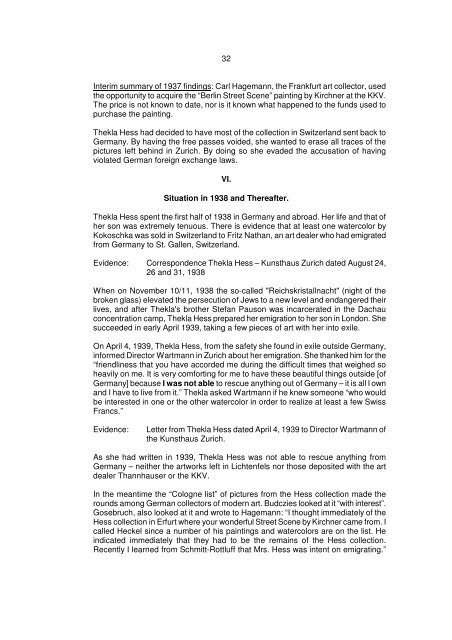Expert Opinion - Nazi Looted Art
Expert Opinion - Nazi Looted Art
Expert Opinion - Nazi Looted Art
Create successful ePaper yourself
Turn your PDF publications into a flip-book with our unique Google optimized e-Paper software.
32<br />
Interim summary of 1937 findings: Carl Hagemann, the Frankfurt art collector, used<br />
the opportunity to acquire the “Berlin Street Scene” painting by Kirchner at the KKV.<br />
The price is not known to date, nor is it known what happened to the funds used to<br />
purchase the painting.<br />
Thekla Hess had decided to have most of the collection in Switzerland sent back to<br />
Germany. By having the free passes voided, she wanted to erase all traces of the<br />
pictures left behind in Zurich. By doing so she evaded the accusation of having<br />
violated German foreign exchange laws.<br />
VI.<br />
Situation in 1938 and Thereafter.<br />
Thekla Hess spent the first half of 1938 in Germany and abroad. Her life and that of<br />
her son was extremely tenuous. There is evidence that at least one watercolor by<br />
Kokoschka was sold in Switzerland to Fritz Nathan, an art dealer who had emigrated<br />
from Germany to St. Gallen, Switzerland.<br />
Evidence: Correspondence Thekla Hess – Kunsthaus Zurich dated August 24,<br />
26 and 31, 1938<br />
When on November 10/11, 1938 the so-called "Reichskristallnacht" (night of the<br />
broken glass) elevated the persecution of Jews to a new level and endangered their<br />
lives, and after Thekla's brother Stefan Pauson was incarcerated in the Dachau<br />
concentration camp, Thekla Hess prepared her emigration to her son in London. She<br />
succeeded in early April 1939, taking a few pieces of art with her into exile.<br />
On April 4, 1939, Thekla Hess, from the safety she found in exile outside Germany,<br />
informed Director Wartmann in Zurich about her emigration. She thanked him for the<br />
“friendliness that you have accorded me during the difficult times that weighed so<br />
heavily on me. It is very comforting for me to have these beautiful things outside [of<br />
Germany] because I was not able to rescue anything out of Germany – it is all I own<br />
and I have to live from it.” Thekla asked Wartmann if he knew someone “who would<br />
be interested in one or the other watercolor in order to realize at least a few Swiss<br />
Francs.”<br />
Evidence: Letter from Thekla Hess dated April 4, 1939 to Director Wartmann of<br />
the Kunsthaus Zurich.<br />
As she had written in 1939, Thekla Hess was not able to rescue anything from<br />
Germany – neither the artworks left in Lichtenfels nor those deposited with the art<br />
dealer Thannhauser or the KKV.<br />
In the meantime the “Cologne list” of pictures from the Hess collection made the<br />
rounds among German collectors of modern art. Budczies looked at it “with interest”.<br />
Gosebruch, also looked at it and wrote to Hagemann: “I thought immediately of the<br />
Hess collection in Erfurt where your wonderful Street Scene by Kirchner came from. I<br />
called Heckel since a number of his paintings and watercolors are on the list. He<br />
indicated immediately that they had to be the remains of the Hess collection.<br />
Recently I learned from Schmitt-Rottluff that Mrs. Hess was intent on emigrating.”


